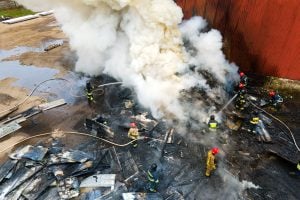
A former fire-protection engineer, Olivas knew that response times can make a crucial difference in terms of loss of life and property when fires happen. So he designed a system of autonomous fleet drones that can use 911 data to locate and report to incident scenes to provide aid in half the time it would take traditional, on-the-ground fire department personnel.
Q1: How did this problem come to your attention?
My project aims to reduce human death and injury as well as property loss from fires that are large and serious enough that the fire department is needed. My project focuses primarily on commercial and residential fires, rather than those occurring on wildland.
I have an undergraduate degree in fire protection and safety technology from Oklahoma State University. My first job out of college was as a fire protection engineer, and I still currently have lots of friends and family in the fire service industry, so this is a problem I am very passionate about.
Q2: How did you use a systems engineering approach in creating your system?
First, I conducted a literature review of reducing fire loss from the emergency response side of the problem. From there, I started evaluating where fire loss typically occurs and why. Understanding the “why” behind the problem led me to start identifying how to fill in those gaps. Understanding the needs for the system from different perspectives was the most important piece for me, as that would define the system’s success. Then I started maturing the initial concept by developing the requirements after evaluating system behavior, use cases (how a user uses a system to accomplish a particular goal), risks, trade studies, and other tools in my systems engineering toolkit.
My project consultants were critical in helping to develop the system further, as their experiences in the fire service provided a unique perspective.
Q3: What is your solution? How does it do the job better than systems already in use?
Early mitigation has been shown to reduce loss (whether property or death and injury) in fire emergencies. Therefore, the system is intended to bridge the gap between when an incident starts and when first responders actually arrive at the scene. My autonomous fleet of drones is designed to travel to incidents aerially when location data from 911 calls and/or fire alarm systems is received at the 911 system. The drones are intended to be scattered at different locations throughout a city to provide effective coverage and shorter travel time. These drones are also designed to interface with responding fire trucks to provide first responders with real-time information regarding the responding drones, which includes actions already performed, incident information, and scouting data. Upon arrival at the incident, the drones will begin supporting the incident through their different capabilities ranging from fire mitigation, medical support, and scouting. For example, at least one drone will be equipped with Automated External Defibrillator (AED) capabilities to provide service to victims in need with assistance from another person present at the scene. Other services that can be provided by field-support drones include the capability to deploy fire extinguisher balls to extinguish a fire via controls from remote operators and the capability to transport essential supplies to victims such as epi-pens, fire blankets, water, and small oxygen tanks.
The system isn’t designed to replace first responders, but rather to supplement their response to help the victims of the incident. Other systems currently exist that are intended to help after first responders arrive at the scene (which this solution will do as well), but the pre-support of incidents is where the system really stands out.
Q4: Why is this work important? Do you see your solution working in real life?
I haven’t seen another system like this before, outside of sci-fi movies. Therefore, there would need to be a lot more development of the system concept, some regulatory hurdles to overcome, and cultural acceptance. But fundamentally, I think the solution is viable. A lot of industries are starting to migrate toward autonomous and robotic solutions, so it makes sense that the fire service eventually uses this type of solution to supplement their response. Taking a systems approach to some of these complex problems like fire loss and letting a solution naturally develop is the first step to providing a greater benefit to those in need during a fire emergency.
Q5: Will you continue to work on this project?
Unfortunately, I will not be further developing this system. My current work and the new addition to my family (little girl almost four months old now) doesn’t leave me much free time. Maybe sometime in the future, I’ll get back to it, but for now it’s on the shelf.
Q6: How have your studies in the Systems Engineering program played a role in the project development?
The systems engineering program was crucial to helping me complete the project. Being able to go back and reference course files and previous assignments, and working with my mentor, Bob Krzystan, senior advisory engineer at Northrop Grumman Corporation and Engineering for Professionals faculty member, was extremely helpful. With each class, a better foundation and refinement of fundamental principles was formed, and I was able to use all that experience and apply it to my project development.
The systems engineering program as a whole was an amazing experience, and the final project was fun and a great way to bring together and apply my practical experience and theoretical knowledge. The courses taken helped establish a solid foundation that I use in my current job. I’m looking forward to seeing how the program helps me even more in the future.